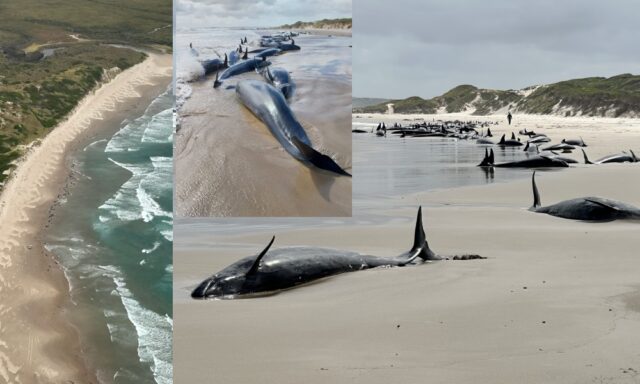Hobart: Wildlife officials in Australia have euthanized 90 false killer whales stranded on a remote beach in Tasmania. Rough ocean conditions prevented rescue teams from refloating the whales back into the sea. Over 150 whales were discovered stranded near Arthur River on Tasmania’s west coast on Tuesday. By Wednesday morning, only 90 remained alive, struggling in shallow waters. Rescuers tried to guide two back into the ocean, but they quickly returned to shore.
Challenging Conditions
Strong winds and rough seas made it impossible for the whales to swim past the breaking waves. “They just keep turning around and coming back,” said Shelley Graham of Tasmania Parks & Wildlife Service. Aerial images showed whales scattered across the beach, some partially buried in sand. Others remained stuck in shallow waters near rocky areas, unable to escape. Authorities decided euthanasia was necessary to prevent further suffering.
Historical Stranding
The last major false killer whale stranding in Tasmania happened 50 years ago. In June 1974, a pod of 160 to 170 whales stranded on Black River beach. It remains unclear how many survived that earlier event. Mass whale strandings are not uncommon in Tasmania, but survival rates are usually low. Marine experts say beached whales start deteriorating after about six hours on land.
Difficult Decision
Authorities said the whales had become highly distressed and disoriented after hours on the shore. In past rescues, heavy machinery helped relocate stranded whales to stabilize them before release. This time, the remote location made it impossible to transport the necessary equipment. “There was no way to get machinery to the area,” said Brendon Clark of Tasmania Parks & Wildlife. Officials confirmed that euthanasia was the most humane option.
Public Warnings
Officials warned the public to stay away from the beach for safety reasons. False killer whales can weigh between 500 kilograms and three tons, posing risks to rescuers. Even after death, whales remain protected under Tasmanian law, and disturbing carcasses is illegal. Wildlife officers are now managing the cleanup while monitoring the area for further strandings. The cause of the mass stranding remains unknown, but marine scientists continue their investigations.











